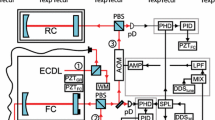Abstract
We present an external cavity diode laser setup using two identical, commercially available interference filters operated in the blue wavelength range around 450 nm. The combination of the two filters decreases the transmission width, while increasing the edge steepness without a significant reduction in peak transmittance. Due to the broad spectral transmission of these interference filters compared to the internal mode spacing of blue laser diodes, an additional locking scheme, based on Hänsch–Couillaud locking to a cavity, has been added to improve the stability. The laser is stabilized to a line in the tellurium spectrum via saturation spectroscopy, and single-frequency operation for a duration of two days is demonstrated by monitoring the error signal of the lock and the piezo drive compensating the length change of the external resonator due to air pressure variations. Additionally, transmission curves of the filters and the spectra of a sample of diodes are given.





Similar content being viewed by others
References
C.E. Wieman, L. Hollberg, Using diode lasers for atomic physics. Rev. Sci. Instrum. 62(1), 1–20 (1991). http://scitation.aip.org/content/aip/journal/rsi/62/1/10.1063/1.1142305
L. Ricci, M. Weidemüller, T. Esslinger, A. Hemmerich, C. Zimmermann, V. Vuletic, W. König, T. Hänsch, A compact grating-stabilized diode laser system for atomic physics. Opt. Commun. 117(5), 541–549 (1995). http://www.sciencedirect.com/science/article/pii/003040189500146Y
X. Baillard, A. Gauguet, S. Bize, P. Lemonde, P. Laurent, A. Clairon, P. Rosenbusch, Interference-filter-stabilized external-cavity diode lasers. Opt. Commun. 266(2), 609–613 (2006). http://www.sciencedirect.com/science/article/pii/S0030401806004561
S. Nakamura, S.F. Chichibu, Introduction to Nitride Semiconductor Blue Lasers and Light Emitting Diodes (Taylor & Francis, Boca Raton, 2000)
D.J. Thompson, R.E. Scholten, Narrow linewidth tunable external cavity diode laser using wide bandwidth filter. Rev. Sci. Instrum. 83(2), 023107 (2012). http://scitation.aip.org/content/aip/journal/rsi/83/2/10.1063/1.3687441
T. Führer, D. Stang, T. Walther, Actively controlled tuning of an external cavity diode laser by polarization spectroscopy. Opt. Express 17, 4991–4996 (2009). http://www.opticsexpress.org/abstract.cfm?URI=oe-17-7-4991
T. Führer, S. Euler, T. Walther, Model for tuning an external-cavity diode laser by polarization locking. J. Opt. Soc. Am. B 28(3), 508–514 (2011). http://josab.osa.org/abstract.cfm?URI=josab-28-3-508
T.Hänsch, B. Couillaud, Laser frequency stabilization by polarization spectroscopy of a reflecting reference cavity. Opt. Commun. 35(3), 441–444 (1980). http://www.sciencedirect.com/science/article/pii/0030401880900693
OSRAM Opto Semiconductors, Blue Laser Diode in TO38 ICut Package (data sheet, 2013). http://www.osram-os.com/Graphics/XPic5/00193831_0.pdf/PL%20450B.pdf
Y. Shimada, Y. Chida, N. Ohtsubo, T. Aoki, M. Takeuchi, T. Kuga, Y. Torii, A simplified 461-nm laser system using blue laser diodes and a hollow cathode lamp for laser cooling of Sr. Rev. Sci. Instrum. 84(6), 063101 (2013). http://www.ncbi.nlm.nih.gov/pmc/articles/PMC3689831/
T. Dutta, D.D. Munshi, M. Mukherjee, Absolute Te\(_2\) reference for barium ion at 455.4 nm. J. Opt. Soc. Am. B 33(6), 1177–1181 (2016). http://josab.osa.org/abstract.cfm?URI=josab-33-6-1177
J. Cariou, P. Luc, Atlas du Spectre d’Absorption de la Molécule de Tellure. \(21100\,\text{cm}^{-1} - 23800\,\text{cm }^{-1}\) (Laboratoire Aime-Cotton, 1980). http://www.lac.u-psud.fr/spip.php?article497
Acknowledgements
We dedicate this contribution to Ted Hänsch in honor of his 75th birthday. Without his seminal contributions to physics in general, laser science and technology, atomic physics, and quantum optics in specific, modern physics would not be as fascinating as it is, and the work reported here would not have been possible. We wish to thank Holger John and the group of Thomas Walther for fruitful discussions and advise on the laser design and the support with the OSA measurements. We appreciate the contributions of Florian Vollrath to the stabilization system. This work received partial financial support from the Deutsche Forschungsgemeinschaft (DFG) under the Grant No. BI 647/4-1. A. Martin and P. Baus acknowledge support from HGS-HIRe. We thank the ARTEMIS collaboration for continuing support. The experiments have been performed within the framework of the HITRAP facility at the Helmholtz Center for Heavy Ion Research (GSI) and the Facility for Antiproton and Ion Research (FAIR) at Darmstadt.
Author information
Authors and Affiliations
Corresponding author
Additional information
This article is part of the topical collection “Enlightening the World with the Laser” - Honoring T. W. Hänsch guest edited by Tilman Esslinger, Nathalie Picqué, and Thomas Udem.
Rights and permissions
About this article
Cite this article
Martin, A., Baus, P. & Birkl, G. External cavity diode laser setup with two interference filters. Appl. Phys. B 122, 298 (2016). https://doi.org/10.1007/s00340-016-6575-9
Received:
Accepted:
Published:
DOI: https://doi.org/10.1007/s00340-016-6575-9




